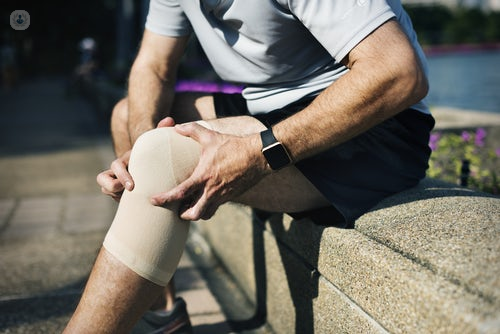Treating arthritis of the knee
Escrito por:The prevalence of hip and knee arthritis continues to grow in the U.K. For over 100 years, surgeons have been trying to solve the problem. It is estimated that 20% of all primary care consultations are related to musculoskeletal problems and at present, there are over 160,000 hip and knee replacements carried out every year.
Mr David Houlihan-Burne talks about the surgical and non-surgical options that are available to treat knee arthritis.

Who typically suffers from knee arthritis?
Usually, patients are over the age of 50 and will experience knee pain that gradually worsens over time. The pain can be global or localized to the front, back or side of the knee. The pain is often accompanied by swelling and a change in the alignment of the leg, for example, bowing of the legs ( varus deformity ). The patient may suffer from a lack of joint mobility and be unable to fully straighten or bend the knee.
A thorough examination by a specialist and a radiograph can diagnose arthritis.
What treatment options are available to patients?
Non-surgical treatments
When a patient first presents with hip or knee pain, all conservative treatments should be tried, before considering joint replacement.
Non-surgical treatments available include;
- Use of analgesics
- Physiotherapy
- Placement of a brace around the mal-aligned leg to take the load off the joint
- Injection therapy; injecting steroids, hyaluronic acids or blood products (stem cells) into the joint
It is worth noting that hyaluronic acids are only effective for pain relief at the early stages of arthritic knee and although injecting blood products, like stem cells to cure arthritis is receiving much media attention, there is not sufficient evidence, at present to prove that stem cells are a cure.
Surgical treatment
When a patient continues to suffer from severe joint pain, which interferes with their daily life despite using the inventions mentioned above; use of steroids and exercises etc., then they should consult with an orthopaedic surgeon to talk about surgery as a solution.
Surgery could be an osteotomy or joint replacement. Arthroscopic surgery is not sufficient to treat and manage advanced arthritis of the knee.
Osteotomy: This surgery involves re-alignment of the knee. It is performed on younger, active patients, but it is usually a temporary solution. The operation can delay the need for joint replacement for 10-25 years.
Joint replacement: Joint replacement remains the gold standard treatment for a 10-15 year osteoarthritis of the knee. The number of joint replacement surgeries in the UK is increasing because the surgery is so effective in relieving pain and allows patients to return to their day to day activities quite quickly.
How have new developments improved joint replacement surgery?
Materials have greatly improved. Previously steel and iron were used to replace the joint. Now materials can last for decades if they are taken care of. Prostheses with a high ODEP rating are shown to last longer.
Modern anaesthesia and analgesic techniques have reduced side effects and discomfort associated with painkillers and general anaesthetic. Patients are now offered surgery under regional anaesthesia (epidural) and sedated, so they sleep during the operation. These techniques have reduced complications and patients can start walking again on the same day as the operation.
Although total joint replacement is effective at relieving pain and restoring function to the knee, there are still about 10% of patients who remain dissatisfied with their new joint, after surgery. Current research is focused on continually improving the surgery.
At BUPA Cromwell, Mr Houlihan-Burne and the Fortius Arthroplasty unit are working to achieve the best possible outcomes for patients of joint replacement surgery, using a team-based approach, focused on pre-operative and post-operative pain management and patient education. The team use, only joint replacements with a high ODEP rating that last longer and combined with modern surgical techniques, allow for quick recovery, rapid return to function and a long lifespan for the new joint.
If you would like to talk about joint replacement with Mr David Houlihan-Burne visit his profile or visit 3 Rivers orthopaedic and sports injury clinic or more information about joint replacement options.


